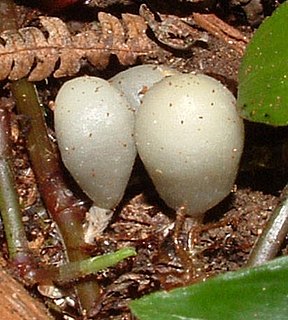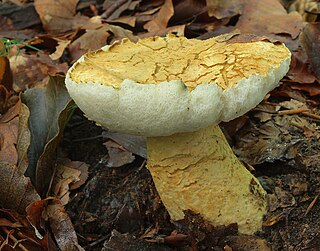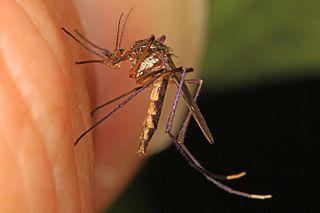
Psilocybe cyanescens is a species of potent psychedelic mushroom. The main compounds responsible for its psychedelic effects are psilocybin and psilocin. It belongs to the family Hymenogastraceae. A formal description of the species was published by Elsie Wakefield in 1946 in the Transactions of the British Mycological Society, based on a specimen she had recently collected at Kew Gardens. She had begun collecting the species as early as 1910. The mushroom is not generally regarded as being physically dangerous to adults. Since all the psychoactive compounds in P. cyanescens are water-soluble, the fruiting bodies can be rendered non-psychoactive through parboiling, allowing their culinary use. However, since most people find them overly bitter and they are too small to have great nutritive value, this is not frequently done.

Panaeolus is a genus of small, black-spored, saprotrophic agarics. The word Panaeolus is Greek for "all variegated", alluding to the spotted gills of the mushrooms produced.

Panaeolus cyanescens is a mushroom in the Bolbitiaceae family. Panaeolus cyanescens is a potent psilocybin mushroom and is similar to Panaeolus tropicalis.

Panaeolus bisporus, also known as Copelandia bisporus is a rare and widely distributed little brown mushroom that bruises blue and contains the hallucinogen psilocybin.

The blue paradise flycatcher is a species of bird in the family Monarchidae. It is endemic to Palawan.

Psilocybe cyanofibrillosa, also known as rhododendron psilocybe and blue-haired psilocybe, is a psilocybin mushroom of the family Hymenogastraceae having psilocybin and psilocin as main active compounds. First documented in 1980 in the Pacific Northwest, it is relatively uncommon and can be distinguished from other closely related species by its smaller spores and forking cheilocystidia. Psilocybe cyanescens also has forking cheilocystidia, but less often than Psilocybe cyanofibrillosa. Psilocybe cyanofibrillosa is also distinguished from Psilocybe cyanescens by an absence of pleurocystidia. The name of this species refers to the fibrils on the Stipe (mycology) that turn bluish in age, or when handled.

Psilocybe weraroa is a secotioid fungus in the family Hymenogastraceae. It is endemic to New Zealand. This species is closely related to Psilocybe cyanescens and is in both the section Cyanescens and the Cyanescens phylogenetic clade. As a bluing member of the genus Psilocybe it contains the psychoactive compounds psilocin and psilocybin.

Gyroporus cyanescens, commonly known as the bluing bolete or the cornflower bolete, is a species of bolete fungus in the family Gyroporaceae. First described from France in 1788, the species is found in Asia, Australia, Europe, and eastern North America, where it grows on the ground in coniferous and mixed forests.

Psilocybe allenii is a species of agaric fungus in the family Hymenogastraceae. Described as new to science in 2012, it is named after John W. Allen, who provided the type collection. It is found in the northwestern North America from British Columbia, Canada to Los Angeles, California, most commonly within 10 miles (16 km) of the Pacific coast.

Nemophas is a genus of longhorn beetles of the subfamily Lamiinae, containing the following species:
Nemophas grayii is a species of beetle in the family Cerambycidae. It was described by Francis Polkinghorne Pascoe in 1859, originally under the genus Monohammus. It is known from Moluccas.

Nemophas incensus is a species of beetle in the family Cerambycidae. It was described by Francis Polkinghorne Pascoe in 1866. It is known from Moluccas.
Nemophas leuciscus is a species of beetle in the family Cerambycidae. It was described by Francis Polkinghorne Pascoe in 1866. It is known from Moluccas.

Nemophas ramosi is a species of beetle in the family Cerambycidae. It was described by Schultze in 1920, originally as a subspecies of Nemophas rosenbergii. It is known from the Philippines.

Nemophas subterrubens is a species of beetle in the family Cerambycidae. It was described by Heller in 1924. It is known from the Philippines.
Nemophas tomentosus is a species of beetle in the family Cerambycidae. It was described by Buquet in 1859, originally under the genus Apriona. It is known from the Solomon Islands and Papua New Guinea.
Nemophas trifasciatus is a species of beetle in the family Cerambycidae. It was described by Heller in 1919. It is known from Moluccas.
Nemophas zonatus is a species of beetle in the family Cerambycidae. It was described by Lansberge in 1880. It is known from Indonesia.

Psorophora cyanescens is a species of mosquito in the family Culicidae.














